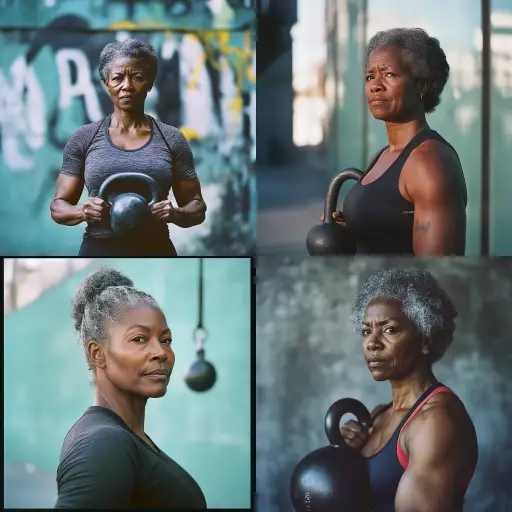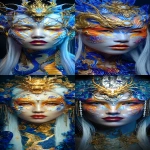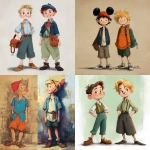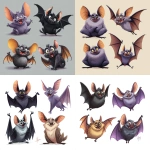Explore the Best AI Image Gallery

Beyond the Brush: How Wearable Tech is Transforming Artistic Creation
The canvas has expanded beyond traditional mediums. Artists are now wielding technology as an extension of their creative vision, pushing boundaries and reimagining what art can be. At the forefront of this revolution stands wearable tech, a dynamic force reshaping the landscape of artistic creation.
From smart glasses that translate emotions into visual art to gloves that capture the nuances of movement and transform them into mesmerizing digital sculptures, wearable technology is empowering artists with unprecedented tools for self-expression.
Unlocking New Dimensions of Creativity
Wearable tech isnt just about replacing traditional tools; its about augmenting human creativity by providing new ways to perceive, interact with, and translate ideas into tangible art forms.
- Augmented Reality (AR) and Virtual Reality (VR): Immersive experiences created through AR and VR headsets allow artists to build interactive worlds, sculpt in 3D space, and explore concepts beyond the limitations of the physical realm.
- Motion Capture and Biofeedback: Wearable sensors can capture intricate movements and physiological data, translating them into dynamic artistic expressions. Imagine a dancers every gesture becoming a flowing line of light or a musicians heartbeat dictating the rhythm of a digital symphony.
- Gesture Recognition and Brain-Computer Interfaces (BCIs): By interpreting hand gestures or brain signals, wearable tech can enable artists to create art purely through thought. This opens up exciting possibilities for neurodiverse creators and those with physical limitations, empowering them to express themselves in new and groundbreaking ways.
Bridging the Gap Between Artist and Audience
Wearable tech is also transforming how audiences experience art, blurring the lines between observer and participant:
- Interactive Installations: Wearables can transform static displays into dynamic experiences. Imagine walking through an art exhibit where your movements trigger light patterns or sound installations, creating a personalized journey through the artwork.
- Personalized Artistic Experiences: Through AR overlays on smartphones or smart glasses, viewers can access additional information about artworks, delve deeper into the artists intentions, or even interact with elements of the piece in real-time.
Ethical Considerations: Navigating Uncharted Territory
As wearable tech becomes increasingly integrated into artistic creation, it raises important ethical questions that need careful consideration:
- Ownership and Authenticity: Who owns the copyright to art created with the assistance of AI algorithms or wearable tech? How do we define authorship in a world where technology plays an increasingly active role in the creative process?
- Accessibility and Inclusivity: ** While wearable tech has the potential to democratize art, ensuring equitable access for all creators remains crucial.
- Privacy Concerns: Wearables often collect vast amounts of personal data. Its essential to establish clear guidelines and safeguards to protect user privacy while utilizing this data responsibly in artistic contexts.
The Future of Art: A Collaborative Symphony
The future of art lies in a harmonious collaboration between human ingenuity and technological advancement. Wearable tech will continue to evolve, offering artists new tools for self-expression and pushing the boundaries of creative exploration.
As we navigate this exciting frontier, it is imperative to embrace ethical considerations, foster inclusivity, and ensure that technology serves as a catalyst for amplifying human creativity rather than replacing it.







](https://images.ai-img.art/thumbnails/150/2fbd98ecfc425cfc1597779121e1c0305437067779e9c471eb64ff9615d5be98.webp)








](https://images.ai-img.art/thumbnails/150/3020b8c2b6d9be07e042357107af1de10deb274a41d2b0f332684ad4b532a702.webp)







](https://images.ai-img.art/thumbnails/150/269414b0e541026702e9e67c67602c96162f37ff460a388b3b36314c8fc936dd.webp)

](https://images.ai-img.art/thumbnails/150/485c8b1c747827bdc9a962f8a1919b3c259b18dd263b260208a1eae19fb85e07.webp)










](https://images.ai-img.art/thumbnails/150/5197af8969d850e2a43e141d41e482ccbceedebceb2a4caf9f098f943f9d1b0f.webp)




](https://images.ai-img.art/thumbnails/150/8d1fe5a7a49cfc96747182431a853357913286d89258383caab2d3b4681afcb5.webp)






